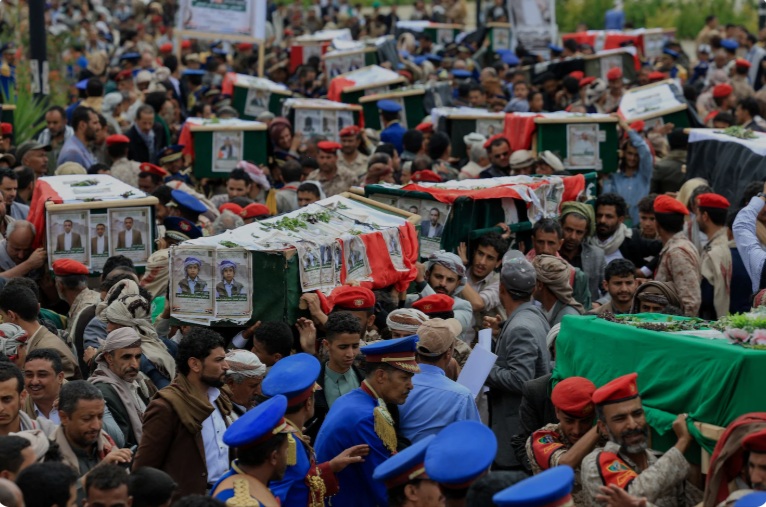Israel’s killing of 31 Yemeni journalists marks deadliest global attack in 16 years
Washington, D.C., September 19, 2025— Israel’s targeted strikes on two newspaper offices in Yemen’s capital, Sanaa, which killed 31 journalists and media support workers on September 10, signal that its deadly pattern of attacking reporters and newsrooms on the grounds that they publish “terrorist” propaganda has spread firmly across the Middle East.

Yemen’s 26 September newspaper was the first to name the 31 killed by multiple strikes on its office and that of the Yemen newspaper, both in the government’s Moral Guidance Directorate’s headquarters. All but one of the dead worked for the two outlets.
Nasser Al-Khadri, editor-in-chief of 26 September, described the killings as an “unprecedented massacre of journalists,” with multiple strikes hitting its newsroom at around 4:45 p.m. as staff were finalizing publication of the weekly paper, which is the Yemeni army’s official outlet.
“It is a brutal and unjustified attack that targeted innocent people whose only crime was working in the media field, armed with nothing but their pens and words,” he told CPJ, adding that many colleagues were reduced to body parts.
A child, who had accompanied a journalist to work, was among the dead, Al-Khadri said, while 22 journalists were injured.
The incident is the second deadliest single attack on the press ever recorded by CPJ, following the 2009 Maguindanao massacre in the Philippines, in which 32 journalists were among those killed when a convoy was ambushed.
Al-Khadri called on the international community to take a firm stance.
“The Israeli military destroyed the newspapers’ facilities, printing presses, and archives. The archive of 26 September is one of Yemen’s most important historical records, documenting the country’s history since the last century, and its loss is deeply painful,” he told CPJ.
 Fighters loyal to Yemen’s Houthis carry caskets during a funeral for those killed in Israeli airstrikes, including journalists. (Photo: AFP/ Mohammed Huwais)
Fighters loyal to Yemen’s Houthis carry caskets during a funeral for those killed in Israeli airstrikes, including journalists. (Photo: AFP/ Mohammed Huwais)
Smearing journalists as terrorists
Israel’s attack on Yemen echoes previous strikes on Gaza, Lebanon, and Iran, where it has repeatedly failed to distinguish between military targets and journalists, justifying its assassinations by smearing journalists as terrorists or propagandists, without credible evidence. As civilians, journalists are protected under international law, including those working for state-run or armed group-affiliated outlets, unless they take direct part in hostilities.
On September 10, the Israel Defense Forces (IDF) said on X that it had struck “military targets” in Sanaa and northern Al-Jawf Governorate, including the “Houthi Public Relations Department” that distributed “psychological terror.” In a September 18 email to CPJ, the IDF’s Foreign Media Desk added, “The terrorist regime’s Public Relations Department is responsible for distributing and disseminating propaganda messages in the media, including speeches by Houthi leader Abdul-Malik and statements from spokesman Yahya Saree.”
The IDF said the strikes were in response to repeated Houthi attacks on Israel, which the rebels have declared an act of solidarity with Palestinians since the Israel-Gaza war began in 2023. The Iranian-backed Houthis took control of Sanaa in 2014 and have been fighting a Saudi-backed coalition supporting Yemen’s internationally recognized government for a decade.
Abdulrahman Mohammed Mutahar, a journalist living 500 meters from the site, told CPJ the attack caused “massive explosions unlike anything Sanaa had seen since 2015.”
He said about eight missiles reduced the Moral Guidance Directorate headquarters to rubble, leaving some journalists’ bodies buried underneath.
“Targeting journalists aims to silence the truth,” Nabil Al-Asidi, a board member of the Yemeni Journalists Syndicate, told CPJ, adding that several of those killed were prominent, long-standing members of his union.
Israel extends it war on journalists beyond Gaza
CPJ has long documented Israel’s tactic of portraying journalists as combatants to excuse their killing. Months before the current Gaza war, CPJ’s 2023 “Deadly Pattern” report detailed five unsubstantiated claims of terrorism or militant activity against journalists killed by Israeli forces between 2004 and 2018.
CPJ is classifying Israel’s 31 killings in Yemen as murders — deliberate targeting of journalists for their work. Prior to the September 10 attack, CPJ had determined that more than two dozen other journalists and media workers had been murdered by Israel after the start of the war on October 7, 2023.
... ...
Entire text is available at Comitee for protecting journalists web site
Najnovije vesti
-
20. Oct 2025.
The New Denial of Imperialism on the Left
AKTUELNO
Umetnička zadruga u izgradnji: Radionica #1, 6 - 9. jun, Beograd

Saopštenje povodom poziva studenata fakulteta Univerziteta umetnosti u Beogradu











